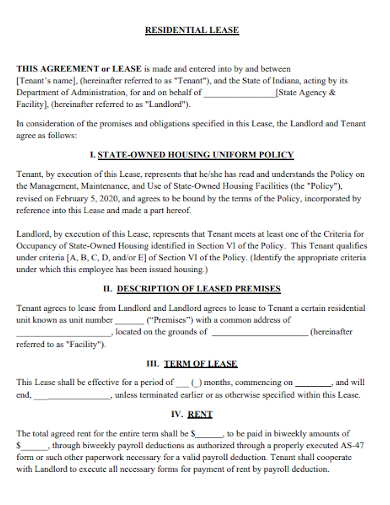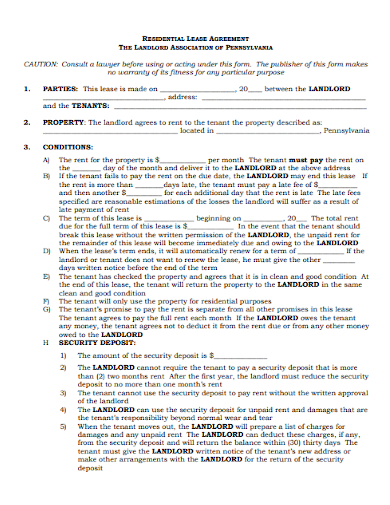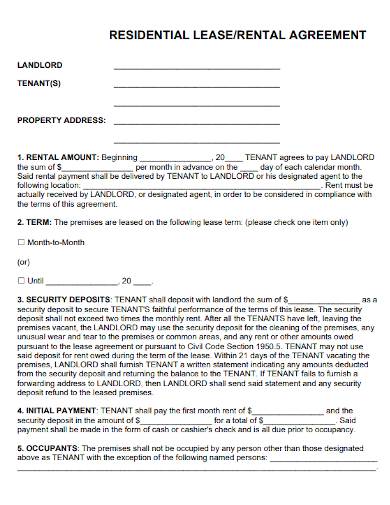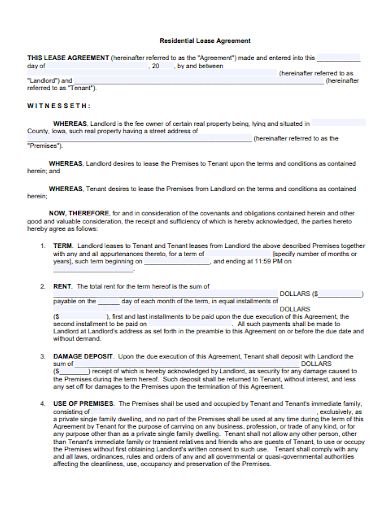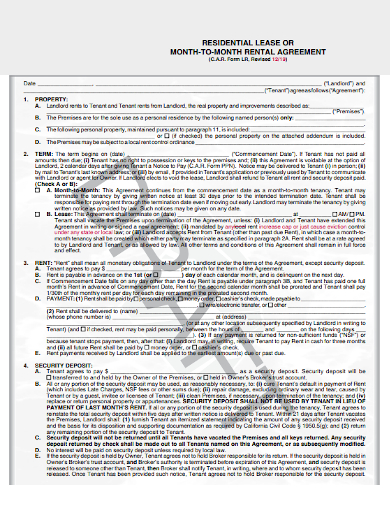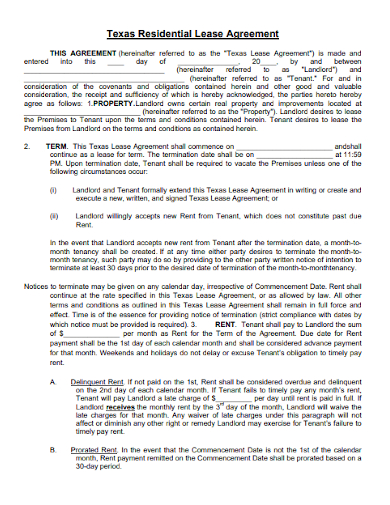A rental or lease agreement is important to create when a landlord decides to rent out their residential property to tenants to protect both you and your tenants by setting expectations and the property’s rules and requirements upfront. It can avoid or mitigate disputes and misunderstandings and help provide clarity to both parties whenever questions or concerns arise. Also, it is required by law to have an agreement to let both the tenant and landlord be responsible during the lease period since both can be accountable when violations happen such as illegal activities on the property and receive penalties for unpaid utility costs, or property damage repairs. This article will guide you on how to create a lease agreement best suited for their residential property.
10+ Residential Rental Lease Agreement
1. Residential Rental Lease Agreement Template
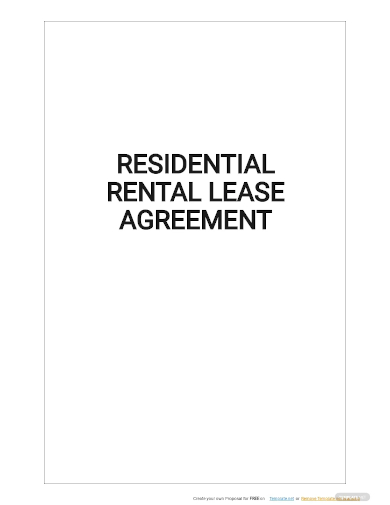
2. Residential Rental Lease Uniform Policy Agreement
3. Tenant Residential Rental Lease Agreement
4. Residential Rental Lease Purchase Agreement
5. Residential Property Rental Lease Agreement
6. Landlord Residential Rental Lease Agreement
7. Sample Residential Rental Lease Agreement
8. Residential Rental Lease Agreement Act
9. Printable Residential Rental Lease Agreement
10. Residential Lease Month to Month Rental Agreement
11. Basic Residential Rental Lease Agreement
What is the Usual Leasing Process?
If you’re curious to know what a leasing process is like, below is a list of sample leasing processes:
- Marketing rental property: The process will start by writing a rental advertisement to describe the home’s best features and high-quality photos of the home’s interior and exterior.
- Hosting an open house or private showing: This lets prospective tenants see the home for them to make sure it meets their needs.
- Reviewing all rental applications: The landlord will screen through prospective tenants’ backgrounds especially their rental history, to see how reliable they are. This will include knowing their employment status, current or previous residences, as well as their financial and criminal background history if local laws will allow this.
How to Make a Residential Lease Tenancy
1. Collect All Party’s Information
The first step to do when creating a lease agreement is to fill out each party’s (both the landlord and tenant) name, phone number, email address, and physical address. If co-owners or additional occupants are living with the tenant, also include their name to document who will be living on the rental property.
2. Include Information About Your Property
No matter which type of rental property you own, you’ll need to include the following information:
- The property address
- If the property is part of a homeowners or condo association
- Any property defects
- Any appliances, furniture, and fixtures included at the property lease
3. Include Details Regarding the Property’s Utilities and Services
Outline any utilities and services that you will provide for your tenants. Some examples of these are:
- Electricity
- Gas
- Heating system
- Water and sewer services
- Trash removal
- Landscaping
- Phone, cable, and internet services
You also need to include information on whether you will cover the cost of these items yourself or if they will be paid by the tenant. If you want the tenant to be responsible for paying the utilities, specify which ones they will be paying and when payment is due.
4. Outline the Terms of the Lease
You should include the important terms of the lease such as the type and length of the lease, the consequences if the tenant breaks the lease, and the situations under which your tenant may end the lease early. Also, be specific with the conditions of termination of the lease and policies on what actions violate the lease that will result in eviction.
5. Set the Monthly Rent
To set your monthly rent, you need to figure out first your base rent. Base rent is the monthly rent before you add any other charges. Make sure your rent complies with rent control laws. In your agreement include these details:
- The total amount due per month
- The due date each month
- The first due date
6. Determine the Payment Method
Determine the payment methods a tenant can pay you with you could state they’re going to pay through electronic payment, cash, checks, or money orders.
7. State the Rights of Both Parties
The tenant and the landlord have certain responsibilities during the lease tenure. Make sure you state that clearly in the agreement. Tenants should comply with the tenant obligations listed in the rental agreement and the landlord should also do the same thing.
8. Determine the Rules You Want to Set
You have the freedom to set rules for your tenant/s to observe to ensure that your property is well-taken care of and make it a more comfortable space for them to live in. When you set your rules, consider the following to include in the agreement:
- Homeowners or condo association rules: Rules that are applied to your neighborhood.
- Consent rules: You can specify your rules regarding certain modifications to the property.
- Safety rules: You can impose restrictions or prohibitions regarding some activities that will impose risk on health and safety to the people occupying your property.
- Maintenance rules: Specify who will be responsible for doing maintenance work such as cleaning the property or who is responsible to take out the trash.
- Key rules: Set rules on key handling and care and set provisions on situations when a key gets lost or tampered with and what actions are required to deal with the situation.
9. Sign the Agreement With the Tenant
Conclude the agreement where you put signature lines where both parties sign it and include the date when it was signed.
FAQs
What are the types of residential agreements?
The different types of residential agreements are:
- Fixed-term leases
- Automatic renewal leases
- Month-to-month lease agreements
- Standard residential rental lease agreements
- Vacation rental agreements
- Sublease agreements
- Room rental agreements
- Commercial lease agreements
What are the four types of tenancy?
the four types of tenancy are:
- Estate for years: This is a type of tenancy created for a fixed period.
- Periodic tenancy: Also known as week-to-week or year-to-year, this type of tenancy continues from one period to the unless either party terminates it at the end of a rental period.
- Tenancy at will: This is a type of tenancy that has no stated duration and may be terminated at any time, by either party.
- Tenancy at sufferance: This is a type of tenancy where a tenant holds over at the end of a valid lease.
Once you’re done drafting the agreement, make sure to review it first and check to see if there are any errors you accidentally input. Make sure to correct those before printing the final copy of the agreement. Discuss it first with your tenant, let them review the contract carefully, and reach a verbal agreement with the contents of the contract first before you sign it. To help you get started making the contract, download our free sample templates above to use as your guide!
Related Posts
FREE 10+ Mentoring Agreement Samples In MS Word | Apple Pages | PDF
FREE 10+ Partner Agreement Samples In MS Word | Google Docs | Apple Pages | PDF
FREE 10+ Individual Agreement Samples In MS Word | Google Docs | Apple Pages | PDF
FREE 10+ Strategic Agreement Samples In MS Word | Google Docs | Apple Pages | PDF
FREE 10+ Equity Agreement Samples In MS Word | Google Docs | Apple Pages | PDF
FREE 10+ Producer Agreement Samples in MS Word | Apple Pages | PDF
FREE 10+ Grant Agreement Samples In MS Word | Apple Pages | PDF
FREE 8+ Meeting Agreement Samples in MS Word | Google Docs | Apple Pages | PDF
FREE 10+ Community Agreement Samples In MS Word | Google Docs | PDF
FREE 8+ Real Estate Option Agreement Samples in MS Word | PDF
FREE 10+ Call Option Agreement Samples In MS Word | PDF
FREE 10+ Advertising Agreement Samples In MS Word | Google Docs | Apple Pages | PDF
FREE 10+ Car Agreement Samples In MS Word | Google Docs | Apple Pages | PDF
FREE 10+ Horse Agreement Samples In MS Word | Apple Pages | PDF
FREE 10+ Option Agreement Samples In MS Word | Google Docs | Apple Pages | PDF

